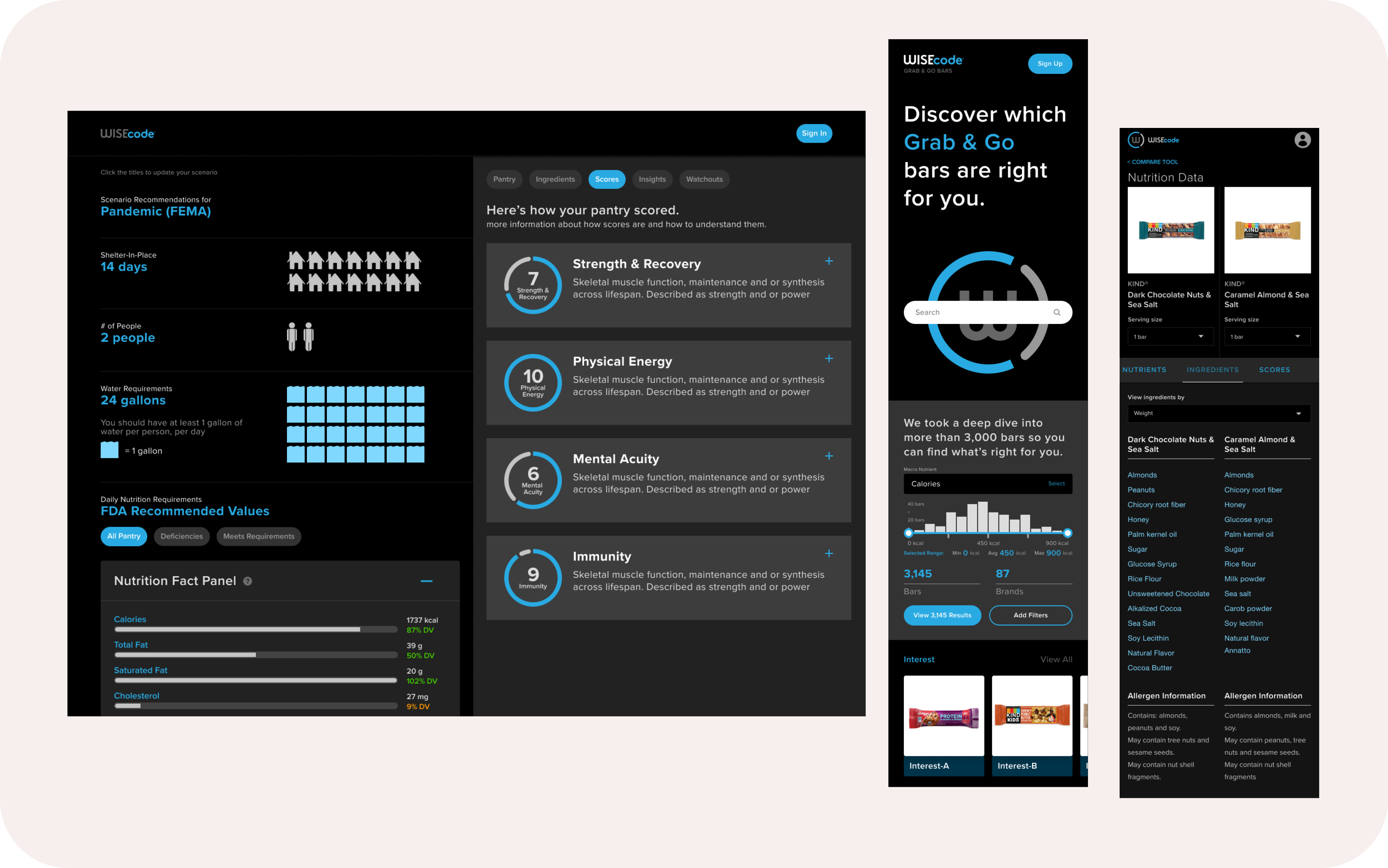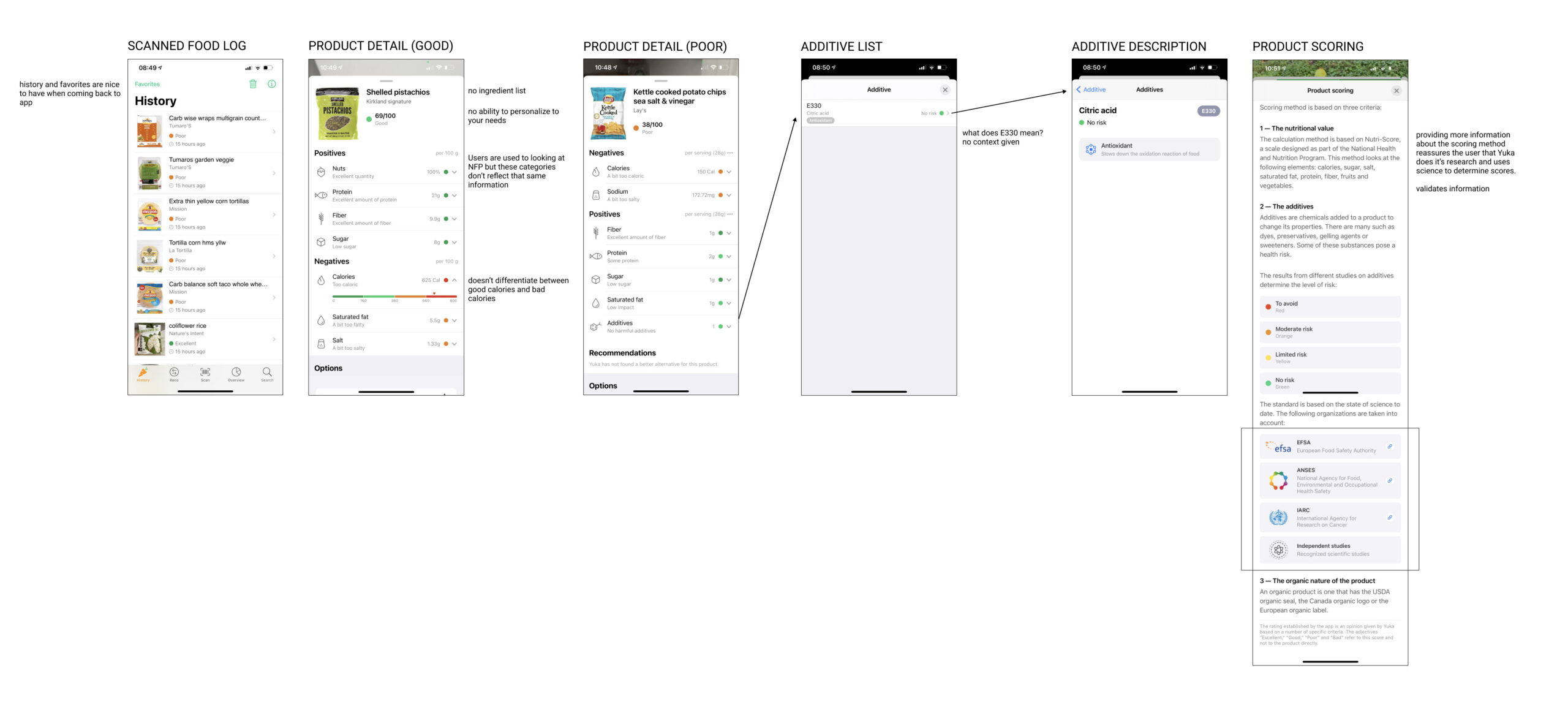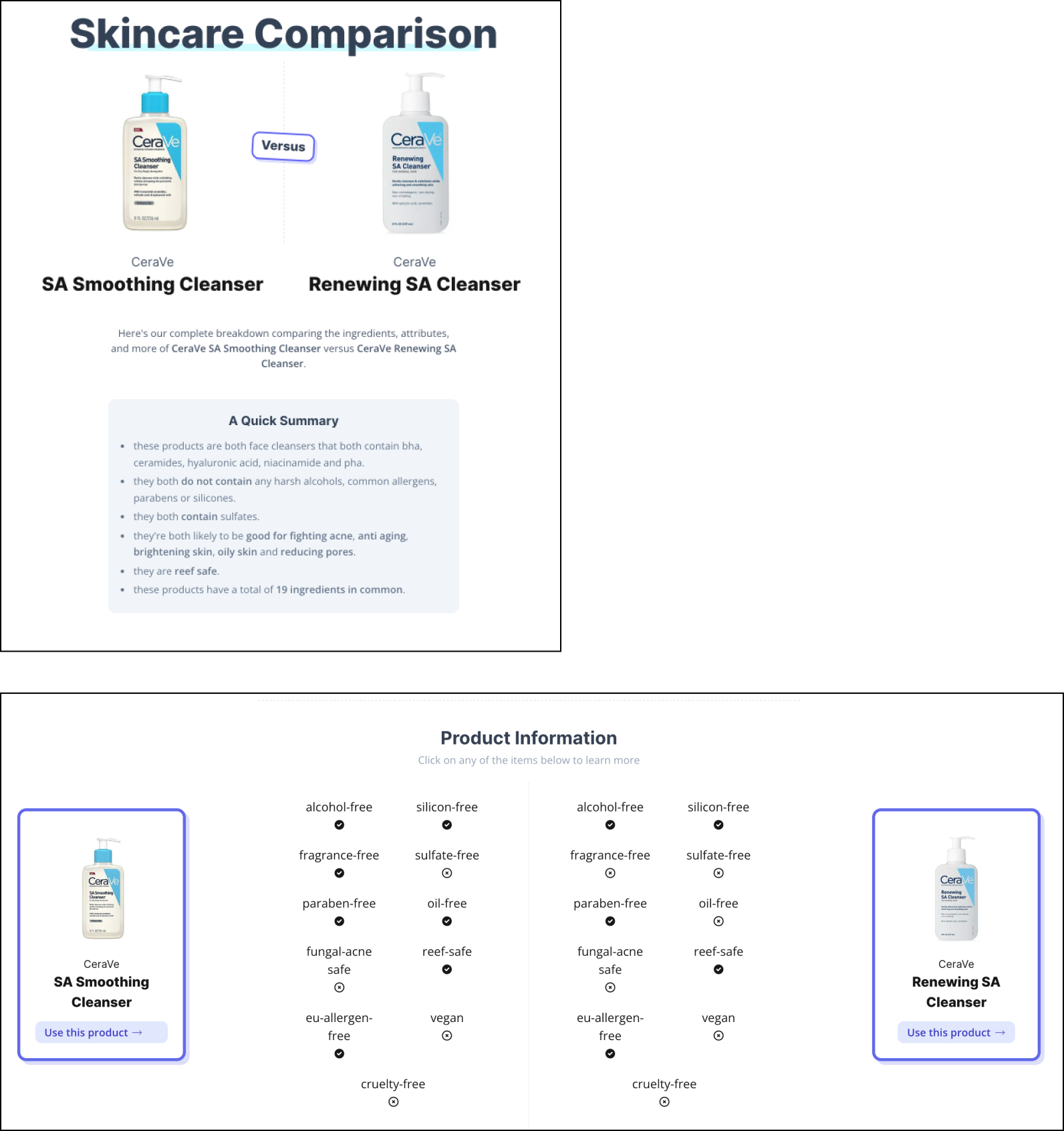
WISEcode is a startup whose goal is to provide precise nutrition data and insights to drive consumers to make better decisions and improve their health and well-being.
Along with two other designers, I was brought on to create conceptual blue sky designs in a variety of situations to demonstrate the opportunity WISEcode nutritional data could have when applied to real-life user scenarios.
Our scope was limited to using basic Nutrition Fact Panel (NFP) information and information found online (due to current WISEcode technology constraints) in order to create an experience that would resonate with nutrition-conscious consumers.
To frame our design thinking, we crafted the following “How Might We” statements in order to align objectives with WISEcode stakeholders and drive our decision-making.
WISEcode is a startup whose goal is to provide precise nutrition data and insights to drive consumers to make better decisions and improve their health and well-being.
My company, Deux Design Co., was brought on to create conceptual blue sky designs in a variety of situations to demonstrate the opportunity WISEcode nutritional data could have when applied to real-life user scenarios.
Our scope was limited to using basic Nutrition Fact Panel (NFP) information and information found online (due to current WISEcode technology constraints) in order to create an experience that would resonate with nutrition-conscious consumers.
To frame our design thinking, we crafted the following “How Might We” statements in order to align objectives with WISEcode stakeholders and drive our decision-making.
How Might We
How Might We
Below are various design concepts I created working in a highly collaborative environment with two other senior designers.
Each project started with a brief from WISEcode leadership, then quickly moved into a high intensity discovery phase where we’d research competitors, understand the business vision, and begin research into user needs, behaviors and pain‐points. We continuously evolved our designs, meeting with stakeholders frequently to show work and collect insights to bring to the next iteration. Each project was shown to their board of investors to demonstrate how WISEcode can use their health and nutrition data to impact consumer’s food decisions.
Below are various design concepts I created working in a highly collaborative environment with two other senior designers.
Each project started with a brief from WISEcode leadership, then quickly moved into a high intensity discovery phase where we’d research competitors, understand the business vision, and begin research into user needs, behaviors and pain‐points. We continuously evolved our designs, meeting with stakeholders frequently to show work and collect insights to bring to the next iteration. Each project was shown to their board of investors to demonstrate how WISEcode can use their health and nutrition data to impact consumer’s food decisions.
Bar Finder
Bar Finder
WISEcode leadership determined that a large percentage of the health community purchased “grab and go” bars and decided to prioritize their research into finding health and nutrition data for these products. The design team was then tasked with creating a responsive website tool to help consumers search and compare these bars to meet their unique health needs.
After receiving the brief, I began researching how consumers searched for a bar that met their requirements. I conducted competitor audits on apps like Yuka and Kroger’s OptUp feature to highlight aspects they were doing well or could improve.

Yuka app flow:

I also uncovered a blog entry from Megan at Metabolism Makeover, a social media health influencer. It describes her very tedious process of visiting Whole Foods and analyzing 50 protein bars using 4 requirements:
Clean ingredients (recognize each ingredient listed)
Good protein source (pea, rice, whey, egg, or collagen)
Healthy source of fat (MCT oil, ghee, egg yolk, coconut)
Net carbs < or = protein + fat
From the 50 bars she analyzed, she only found four protein bars that passed her test. From this research it become very obvious that consumers need a tool that reduces the amount of time and manual effort required to find healthy foods that align with their nutrition goals.
After putting my findings into Figma to create artifacts to align the team around, I began to sketch designs with pen paper.


WISEcode leadership assigned us to design a responsive website tool that helps consumers search and compare “grab & go” bars that meet their unique health needs.
After receiving the brief, I began to research how consumers were currently accomplishing this goal. I uncovered a blog entry from Megan at Metabolism Makeover, a social media health influencer. It describes her very tedious process of visiting Whole Foods and analyzing 50 protein bars using 4 requirements:
- Clean ingredients (recognize each ingredient listed)
- Good protein source (pea, rice, whey, egg, or collagen)
- Healthy source of fat (MCT oil, ghee, egg yolk, coconut)
- Net carbs < or = protein + fat

After continuously iterating on the sketches, I created low-fidelity wireframes in Figma to align with the internal team. From the wireframes, we determined the need for an intuitive filter that allowed consumers to take a very granular approach when searching for the right bar based off of their individual motivations.
I worked very closely with the visual designer to transform the wireframes into high fidelity designs prior to presenting to the client.

Filter flow:
Not only could users filter down the 3,000 bar database right on the home page, but once they began to browse items, they could filter down the list to be even more specific (eg. remove all products with cane sugar). This allowed users to find solutions to their very specific needs without having to continuously scroll through hundreds of products and products detail pages.

From the 50 bars she analyzed, she only found four protein bars that passed her test. From this research it become very obvious that consumers need a tool that reduces the amount of time and manual effort required to find healthy foods that align with their nutrition goals.
After dividing tasks up among the UX team, I began to sketch designs for an intuitive filter that allowed consumers to take a very granular approach to searching for the right bar.

Not only could users filter down the 3,000 bar database right on the home page, but once they began to browse items, they could filter down the list to be even more specific (eg. remove all products with cane sugar).

Pantry Planner
Emergencies can be unexpected. People often don’t know what food they need to prepare in order to meet their nutritional requirements during a time of crisis. The Covid pandemic during 2020 and subsequent resource shortages reinforced the necessity for individual households to be better prepared in emergency situations.
Using WISEcode’s existing relationship with Nutrient Survival, a consumer-facing emergency food supplier, we created a concept that would allow users to prepare for various emergency scenarios using FEMA recommendations for preparations each household should have on hand.
Pantry Planner
Emergencies can be unexpected. People often don’t know what food they need to prepare in order to meet their nutritional requirements during a time of crisis. The Covid pandemic during 2020 and subsequent resource shortages reinforced the necessity for individual households to be better prepared in emergency situations.
Using WISEcode’s existing relationship with Nutrient Survival, a consumer-facing emergency food supplier, we created a concept that would allow users to prepare for various emergency scenarios using FEMA recommendations for preparations each household should have on hand.
Because of their relationship with Nutrient Survival, WISEcode created six segment types within the survival community targeted for various projects.
For this project, we focused on the Pantry Prepper segment, which had the largest market size and became increasingly more common after the pandemic, making it very relatable.

Because of their relationship with Nutrient Survival, WISEcode created six segment types within the survival community targeted for various projects.
For this project, we focused on the Pantry Prepper segment, which had the largest market size and became increasingly more common after the pandemic, making it very relatable.

From the discovery phase we came up with “factors to consider” and a list of user needs. These artifacts along with other research findings drove our designs.
From the discovery phase we came up with “factors to consider” and a list of user needs. These artifacts along with other research findings drove our designs.
Factors to consider
- FEMA scenarios: nuclear detonation, winter storm, pandemic
- Size of household
- Duration of preps
- Known allergens
What does user need to know but doesn’t?
- Water needs
- Caloric intake
- NFP information
- Other essential nutrients: Vitamins, Minerals, Aminos, and Omegas
Factors to consider
- FEMA scenarios: nuclear detonation, winter storm, pandemic
- Size of household
- Duration of preps
- Known allergens
What does user need to know but doesn’t?
- Water needs
- Caloric intake
- NFP information
- Other essential nutrients: Vitamins, Minerals, Aminos, and Omegas


Introduction of WISEcode ‘Scores’
Striving to make complicated nutrition data simple, WISEcode created “scores”. These scores are created by WISEcode nutrition scientists and are intended to alleviate the stress and confusion caused by health and food data. Scores take the Daily Recommended Intake (DRI) from WISEcode selected nutrients and calculate a component value, allowing consumers to quickly understand how their pantry ranks from 1 to 10 in various categories. Giving consumers have a reliable data point they can trust that is easy to comprehend.
For example, the Strength and Recovery score takes Daily Recommended Intake (DRI) for 11 nutrients and calculates a score based on the DRI percentage.



Introduction of WISEcode ‘Scores’
Striving to make complicated nutrition data simple, WISEcode created “scores”. These scores are created by WISEcode nutrition scientists and are intended to alleviate the stress and confusion caused by health and food data. Scores take the Daily Recommended Intake (DRI) from WISEcode selected nutrients and calculate a component value, allowing consumers to quickly understand how their pantry ranks from 1 to 10 in various categories. Giving consumers have a reliable data point they can trust that is easy to comprehend.
For example, the Strength and Recovery score takes Daily Recommended Intake (DRI) for 11 nutrients and calculates a score based on the DRI percentage.

Comparison Tool
This concept was rooted in a situation many people have encountered in their daily lives when considering an between-meal snack, “Is there a healthier option?”. Comparing food items and finding a healthy alternative is complex and time-consuming.
WISEcode wanted to give consumers a tool to quickly compare two food items and view nutrition data in a way that was easy to consume.
Using the popular brand, KIND Bars, we were able to demonstrate how someone would start from a known point of origin, explore additional product offerings, and compare the nutritional content between products.
To begin this project, we researched how consumers were currently comparing products for purchase. Each designer completed a competitive analysis and presented it within the design team meetings to share logic and inspiration.
what are ways to communicate this currently?
Comparison Tool
This concept was rooted in a situation many people have encountered in their daily lives when considering an between-meal snack, “Is there a healthier option?”. Comparing food items and finding a healthy alternative is complex and time-consuming.
WISEcode wanted to give consumers a tool to quickly compare two food items and view nutrition data in a way that was easy to consume.
Using the popular brand, KIND Bars, we were able to demonstrate how someone would start from a known point of origin, explore additional product offerings, and compare the nutritional content between products.
To begin this project, we researched how consumers were currently comparing products for purchase. Each designer completed a competitive analysis and presented it within the design team meetings to share logic and inspiration.
what are ways to communicate this currently?




We used the persona, Comparing Carol, throughout the project to guide design decisions, priorities, and create empathy amongst the client and our team.
We then began to sketch concepts, collaborating frequently to show progress and identify any gaps in our thinking. We continuously iterated on our designs and met with stakeholders for alignment and approval.


We used the persona, Comparing Carol, throughout the project to guide design decisions, priorities, and create empathy amongst the client and our team.
We then began to sketch concepts, collaborating frequently to show progress and identify any gaps in our thinking. once
Through design team and stakeholder meetings, we …..


